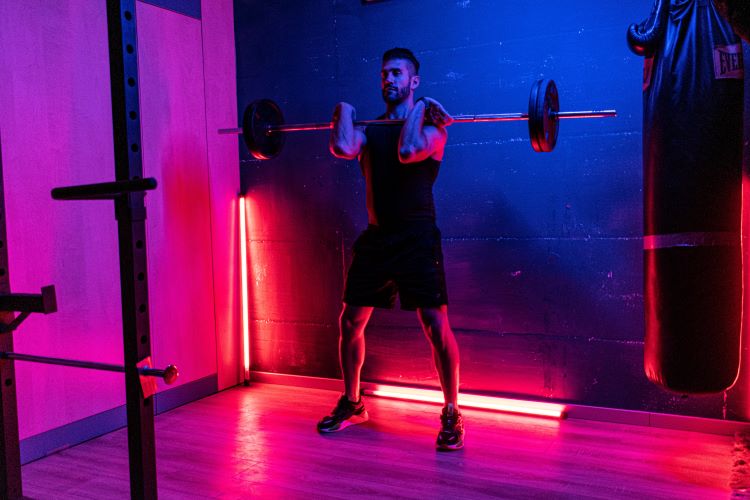Are squats and front squats the same, or is there a difference between them? This comprehensive guide explores the nuances, benefits, and techniques of both to help you make an informed choice.
Do you ever wonder if there’s a significant distinction between squats and front squats? Well, you’re not alone! These two exercises are staples in any fitness routine, but they offer unique benefits and challenges. In this article, we’ll dive deep into the world of squats, shedding light on their differences and helping you choose the best one for your fitness goals.
Introduction
Squats and front squats are popular strength training exercises that target the lower body. While they might seem similar at first glance, they have distinctive characteristics that set them apart. Understanding the differences and knowing when to incorporate them into your workout routine can be a game-changer for your fitness journey.
In this article, we will explore the key distinctions between squats and front squats, along with the benefits they offer. We’ll also provide insights based on personal experiences and credible sources, ensuring you have all the information you need to make an informed choice.
The Basics of Squats
Let’s start with the fundamentals.
Squats: What Are They?
Squats are a compound exercise that primarily targets the muscles in your lower body, including the quadriceps, hamstrings, glutes, and calves. They involve bending your knees and hips to lower your body down and then pushing it back up. The barbell squat, commonly known as the back squat, is one of the most traditional variations.
Benefits of Squats
- Strength and Muscle Development: Squats are renowned for building lower body strength and muscle mass. They engage multiple muscle groups, leading to well-rounded development.
- Improved Mobility: Squats can enhance your hip and ankle mobility, making daily activities easier.
- Functional Fitness: The ability to lift objects from the ground, a common daily task, is improved through squats.
- Fat Loss: Squats burn calories and contribute to fat loss when incorporated into a balanced workout routine.
The Front Squat Difference
Now, let’s delve into front squats and their unique aspects.
Front Squats: A Closer Look
Front squats, as the name suggests, involve holding the barbell in front of your body rather than on your upper back. This variation shifts the emphasis to different muscle groups and provides a fresh perspective on squatting.
What Sets Front Squats Apart?
- Core Activation: Front squats require more core stability as the weight is carried in front, which can be beneficial for strengthening the core muscles.
- Reduced Stress on the Lower Back: The front squat places less strain on the lower back, making it an excellent choice for those with lower back issues.
- Increased Quadriceps Engagement: Front squats emphasize the quadriceps more than back squats, leading to better quad development.
- Improved Posture: Performing front squats can help improve your posture as it encourages an upright position.
Is there a difference between squats and front squats?

So, is there a significant difference between squats and front squats? The answer is yes, and it mainly lies in the way the exercise is performed and the muscle groups targeted.
While squats are fantastic for overall lower body development and strength, front squats offer a different set of advantages, including core activation and reduced stress on the lower back. The best choice between the two depends on your fitness goals and individual circumstances.
If you’re new to squats, it’s advisable to start with traditional squats and then progress to front squats once you’re comfortable with the movement.
Frequently Asked Questions
How do I perform a proper squat?
To perform a squat, stand with your feet shoulder-width apart, keep your chest up, and bend your knees and hips, lowering your body. Ensure your knees don’t go past your toes, and return to the starting position by pushing through your heels.
Are front squats suitable for beginners?
Front squats can be challenging for beginners due to the need for core stability and upper body strength. It’s recommended to start with traditional squats and gradually incorporate front squats into your routine.
Can I do squats and front squats on the same day?
Yes, you can include both squats and front squats in the same workout session. However, it’s essential to ensure proper form and not overexert yourself to prevent injury.
How many reps and sets should I do for squats and front squats?
The number of reps and sets depends on your fitness goals. Typically, 3-4 sets of 8-12 reps are suitable for muscle growth, while 4-5 sets of 4-6 reps are better for strength.
Should I use a lifting belt for front squats?
Using a lifting belt during front squats can provide additional support to your core, especially if you’re lifting heavy weights. However, it’s essential to use it correctly to avoid overreliance on the belt.
Can front squats help with posture improvement?
Front squats encourage an upright position and can contribute to better posture over time. However, focusing solely on front squats for posture improvement may not be sufficient; incorporating other posture-enhancing exercises is advisable.
Conclusion
In the world of fitness, squats and front squats are two powerhouse exercises that offer distinct advantages. Understanding the differences between them and how they align with your fitness goals is crucial.
Remember that both squats and front squats can be valuable additions to your workout routine, but it’s essential to execute them correctly and progressively. Whether you choose traditional squats for overall lower body development or front squats for core activation and posture improvement, both exercises can help you reach your fitness goals.
By exploring the nuances of squats and front squats, you’re on your way to making an informed choice that will enhance your fitness journey.





